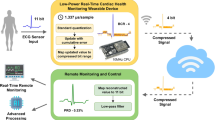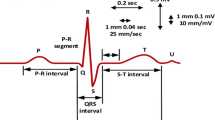Abstract
Electrocardiogram (ECG) signals play an indispensable role in interpreting the heart's effectiveness in the form of electrosignals to diagnose different types of cardiac problems. These vital signals should also be transmitted safely to avoid any interruptions in the data loss or noise that may lead to illness detection. As ECG signals are observed with a higher-dimensional scale, this should be compressed for leveraging accurate control and transportation. A method of lossless compression called Huffman-based discrete cosine transform (DCT) is performed in this manuscript for achieving the efficient transmission of ECG data. DCT and inverse discrete cosine transform (IDCT) are suggested for improving data privacy and lowering the data complexity. This manuscript concentrates on achieving a high level of accuracy ratio in the reconstruction upon compression and transportation of the original data (OrDa) unaccompanied any failure in the lowest computational time. During the first stages, preprocessing and sampling are performed to eliminate the sounds and transmission of OrDa. The DCT-based Huffman quantization approach achieved great performance measures as “distortion percentage”(PRD), “signal-to-noise ration” (SNR), “quality score” (QS), and “compression ration” (CR) when comparing with current approaches in different data transformations.
Access this chapter
Tax calculation will be finalised at checkout
Purchases are for personal use only
Similar content being viewed by others
References
M. Elgendi, Less is more in biosignal analysis: compressed data could open the door to faster and better diagnosis. Diseases (2018)
S. Kalaivani, C. Tharini, Analysis and modification of rice Golomb coding lossless compression algorithm for wireless sensor networks. J. Theor. Appl. Inform. Technol. 96(12), 3802–3814 (2018)
C. Tan, L. Zhang, H.-T. Wu, A novelBlaschke unwinding adaptiveFourier-decomposition-based signal compression algorithm with application on ECG signals. IEEE J. Biomed. Health Inform. 23(2), 672–682 (2019)
A. Burguera, Fast QRS detection and ECG compression based on signal structural analysis (2019)
H. Huang, S. Hu, Y. Sun, ECG signal compression for low-power sensor nodes using sparse frequency spectrum features, in IEEE Biomedical Circuits and Systems Conference (BioCAS) (2018)
https://www.drugs.com/cg/heart-palpitations-in-adolescents.html
A. Burguera, Fast QRS detection and ECG compression based on signal structural analysis. IEEE J. Biomed. Health Inform. 23(1), 123–131 (2019)
A.S. Abdulbaqi, I.Y. Panessai, Designing and ımplementation of a biomedical module for vital signals measurements based on embedded system. Int. J. Adv. Sci. Technol. (IJAST) 29(3), 3866–3877 (2020)
C.J. Deepu, C.-H. Heng, Y. Lian, A hybrid data compression scheme for power reduction in wireless sensors for IoT. IEEE Trans. Biomed. Circuits Syst. 11(2), 245–254 (2017)
C.K. Jha, M.H. Kolekar, ECG data compression algorithm for telemonitoring of cardiac patients. Int. J. Telemed. Clin. Pract. 2(1), 31–41 (2017)
A.S. Abdulbaqi et al., Recruitment Internet of Things For Medical Condition Assessment: Electrocardiogram Signal Surveillance, Special Issue, AUS Journal, (Institute of Architecture and Urbanism, University of Austral de Chile, 2019), pp. 434–440
T.-H. Tsai, W.-T. Kuo, An efficient ECG lossless compression system for embedded platforms with telemedicine applications. IEEE (2018)
A.E. Hassanien, M. Kilany, E.H. Houssein, Combining Support Vector Machine and Elephant Herding Optimization for Cardiac Arrhythmias. arXiv:1806.08242v1[eee.SP], June 20, 2018
J. Dogra, M. Sood, S. Jain, N. Prashar, Segmentation of magnetic resonance images of brain using thresholding techniques,in 4th IEEE International Conference on signal processing and control (ISPCC 2017), Jaypee University of Information technology, Waknaghat, Solan, H.P, India, pp. 311–315, September 21–23, 2017
N. Prashar, S. Jain, M. Sood, J. Dogra, Review of biomedical system for high performance applications ,4th IEEE International Conference on signal processing and control (ISPCC 2017), Jaypee University of Information technology, Waknaghat, Solan, H.P, India, pp 300–304, September 21–23, 2017
A. Dhiman, A. Singh, S. Dubey, S. Jain, Design of lead II ECG waveform and classification performance for morphological features using different classifiers on lead II. Res. J. Pharmaceut. Biol. Chem. Sci. (RJPBCS) 7(4), 1226–1231 (2016)
B. Pandey, R.B. Mishra, An integrated intelligent computing method for the detection and interpretation of ECG based cardiac diseases. Int. J. Knowl. Eng. SoftData Paradigms 2, 182–203 (2010)
A.S. Abdulbaqi, S.A.M. Najim, R.H. Mahdi, Robust multichannel EEG signals compression model based on hybridization technique. Int. J. Eng. Technol. 7(4), 3402–3405 (2018)
S. Kalaivani, I. Shahnaz, S.R. Shirin, C. Tharini, Real-time ECG acquisition and detection of anomalies, in Artificial İntelligence and Evolutionary Computations in Engineering Systems, ed. S.S. Dash, M.A. Bhaskar, B.K. Panigrahi, S. Das (Springer, Berlin, 2016)
J. Uthayakumar, T. Venkattaraman, P. Dhayachelvan, A survey on data compression techniques: from the perspective of data quality, coding schemes, data types, and applications. J. King Saud Univ.- Comput. Inform. Sci. (2018)
R. Gupta, S. Singh, K. Garg, S. Jain, Indigenous design of electronic circuit for electrocardiograph . Int. J. Innov. Res. Sci. Eng. Technol. 3(5), 12138–12145 (2014)
C.C. Chiu, T.H. Lin, B.Y. Liau, Using correlation coefficient in ECG waveforms for arrhythmia detection. Biomed. Eng. Appl. Basis Commun. 17, 147–152 (2005)
S. Jain, Classification of protein kinase B using discrete wavelet transform. Int. J. Inform. Technol. 10(2), 211–216 (2018)
N. Alajlan, Y. Bazi, F. Melgani, S. Malek, M.A. Bencherif, Detection of premature ventricular contraction arrhythmias in electrocardiogram signals with kernel methods. SIViP 8(5), 931–942 (2014)
Y. Hirai, T. Matsuoka, S. Tani, S. Isami, K. Tatsumi, M. Ueda, T. Kamata, A biomedical sensor system with stochastic A/D conversion and error correction by machine learning. IEEE Access 7, 21990–22001 (2019)
Ö. Yildirim, A novel wavelet sequence based on a deep bidirectional LSTM network model for ECG signal classification. Comput. Biol. Med. 96, 189–202 (2018)
A. Diker, D. Avci, E. Avci, M. Gedikpinar, A new technique for ECG signal classification genetic algorithm Wavelet Kernel extreme learning machine. Optik 180, 46–55 (2019)
J. Zhang, Z. Gu, Z.L. Yu, Y. Li, Energy-efficient ECG compression on wireless biosensors via minimal coherence sensing and weighted l1 minimization reconstruction. IEEE J. Biomed. Health Inform. 19(2), 520–528 (2015)
A. Singh, S. Dandapat, Block sparsity-based joint compressed sensing recovery of multi-channel ECG signals. Healthcare Technol. Lett. 4(2), 50–56 (2017)
A. Singh, S. Dandapat, Exploiting multi-scale signal information in joint compressed sensing recovery of multi-channel ECG signals. Biomed. Signal Process. Control 29, 53–66 (2016)
H. Mamaghanian, G. Ansaloni, D. Atienza, P. Vandergheynst, Power-efficient joint compressed sensing of multi-lead ECG signals, in IEEE International Conference on Acoustics, Speech and Signal Processing (ICASSP) 2014, pp. 4409–4412 (2014)
S. Kumar, B. Deka, S. Datta, Block-sparsity based compressed sensing for multichannel ECG reconstruction, in Pattern Recognition and Machine Intelligence. PReMI 2019. Lecture Notes in Computer Science, vol. 11942, ed. by B. Deka, P. Maji, S. Mitra, D. Bhattacharyya, P. Bora, S. Pal (Springer, Cham, 2019)
S. Eftekharifar, T.Y. Rezaii, S. Beheshti, S. Daneshvar, Block sparse multi-lead ECG compression exploiting between-lead collaboration. IET Sig. Process. (2018)
A. Sharma, A. Polley, S.B. Lee, S. Narayanan, W. Li, T. Sculley, S. Ramaswamy, A Sub-60-μ A multimodal smart biosensing SoCwith>80-dB SNR, 35μAphotoplethysmography signal chain. IEEE J. Solid-State Circuits 52(4), 1021–1033 (2017)
Z. Zhang, J. Li, Q. Zhang, K. Wu, N. Ning, Q. Yu, A dynamic tracking algorithm based SAR ADC in bio-related applications. IEEE Access 6, 62166–62173 (2018)
M.K. Adimulam, M.B. Srinivas, A 1.0 V, 9.84 fJ/c-s FOM reconfigurable hybrid SAR-sigma delta ADC for signal processing applications. Analog Integr. Circ. Sig. Process 99(2), 261–276 (2019)
X. Zhang, Y. Lian, A 300-mV 220-NW Event-driven ADC with real-time QRS detection for wearable ECG sensors. IEEE Trans. Biomed. Circuits Syst. 8(6), 834–843 (2014)
Y. Hou, J. Qu, Z. Tian, M. Atef, K. Yousef, Y. Lian, G. Wang, A 61-NW level-crossing ADC with adaptive sampling for biomedical applications. IEEE Trans. Circuits Syst. II Express Briefs 66(1), 56–60 (2019)
Author information
Authors and Affiliations
Corresponding author
Editor information
Editors and Affiliations
Rights and permissions
Copyright information
© 2021 The Author(s), under exclusive license to Springer Nature Singapore Pte Ltd.
About this paper
Cite this paper
Abdulbaqi, A.S., Najim, S.Ad.M., Al-barizinji, S.M., Panessai, I.Y. (2021). A Secured System for Tele Cardiovascular Disease Monitoring. In: Smys, S., Tavares, J.M.R.S., Bestak, R., Shi, F. (eds) Computational Vision and Bio-Inspired Computing. Advances in Intelligent Systems and Computing, vol 1318. Springer, Singapore. https://doi.org/10.1007/978-981-33-6862-0_18
Download citation
DOI: https://doi.org/10.1007/978-981-33-6862-0_18
Published:
Publisher Name: Springer, Singapore
Print ISBN: 978-981-33-6861-3
Online ISBN: 978-981-33-6862-0
eBook Packages: Intelligent Technologies and RoboticsIntelligent Technologies and Robotics (R0)




